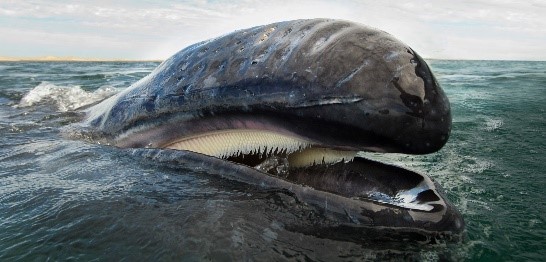Description
 Disclaimer: Copyright infringement not intended.
Disclaimer: Copyright infringement not intended.
Context
- A fossil of Baleen Whales has been found on the banks of the Murray River in South Australia.
Baleen Whales
- Baleen whales, scientifically known as Mysticeti, are a group of large marine mammals belonging to the cetacean order.
- These whales are characterized by the presence of baleen plates, comb-like structures in their mouths, used for filter feeding.
- They play a crucial role in marine ecosystems and have cultural significance in various societies.
Key Species:
Blue Whale (Balaenoptera musculus):
- The blue whale is the largest animal on Earth, with a distinctive mottled blue-gray appearance. It primarily feeds on krill and is found in oceans globally.
Humpback Whale (Megaptera novaeangliae):
- Known for their acrobatic behavior, humpback whales are identified by their long pectoral fins and complex songs. They undertake extensive migrations for breeding and feeding.
Gray Whale (Eschrichtius robustus):
- Gray whales are known for their long migrations between Arctic feeding grounds and breeding lagoons in warmer waters. They exhibit a benthic feeding strategy, scooping sediment and prey from the seafloor.
Minke Whale (Balaenoptera acutorostrata):
- Minke whales are the smallest of the baleen whales and are characterized by a streamlined body. They are found in various oceanic regions and are known for their elusive nature.
Morphology and Adaptations:
Baleen Plates:
- Baleen plates are made of keratin and are used by baleen whales to filter small organisms like krill from the water during feeding.
Filter Feeding:
- Baleen whales are filter feeders. They take in large mouthfuls of water and then use their baleen plates to filter out the water, retaining prey like krill or small fish.

Migration:
- Many baleen whale species undertake extensive migrations between feeding and breeding grounds. These migrations often cover thousands of kilometers.
Songs and Communication:
- Some baleen whales, notably humpback whales, are known for their complex songs. These songs are believed to be related to breeding and communication.
Conservation Status and Threats:
Threats:
- Baleen whales face various threats, including entanglement in fishing gear, ship strikes, pollution, climate change affecting prey availability, and habitat degradation.
- Besides hunting, baleen whales also face threats from marine pollution and ocean acidification.
IUCN Status
- The North Atlantic right whale is ranked Critically Endangered by the International Union for Conservation of Nature.
Conservation Efforts:
- International conservation efforts, such as the International Whaling Commission (IWC), aim to regulate whaling and protect baleen whales. Many countries have implemented measures to reduce ship strikes and fishing gear entanglements.
Cultural Significance:
- Baleen whales have cultural significance in various societies.
- They feature prominently in folklore, art, and traditional practices, emphasizing the interconnectedness between humans and the marine environment.
|
PRACTICE QUESTION
Q. In the realm of marine biology, consider the following assertions regarding baleen whales:
Assertion 1: All baleen whales undertake extensive migrations between feeding and breeding grounds.
Assertion 2: The baleen plates in the mouths of these whales are primarily composed of bone material.
Select the correct code:
A. Both assertions are true, and Assertion 2 is the correct explanation of Assertion 1.
B. Both assertions are true, but Assertion 2 is not the correct explanation of Assertion 1.
C. Assertion 1 is true, but Assertion 2 is false.
D. Assertion 1 is false, but Assertion 2 is true.
The correct answer is:
C. Assertion 1 is true, but Assertion 2 is false.
Explanation:
- Assertion 1 (All baleen whales undertake extensive migrations between feeding and breeding grounds): This statement is generally true. Many baleen whale species, such as humpback whales and gray whales, are known for their extensive migrations between their feeding grounds in colder waters and their breeding or calving grounds in warmer waters. This behavior is a characteristic feature of baleen whale life cycles.
- Assertion 2 (The baleen plates in the mouths of these whales are primarily composed of bone material): This statement is false. The baleen plates in the mouths of baleen whales are not composed of bone material; instead, they are made of keratin, the same protein found in human hair and nails. Baleen plates are comb-like structures that baleen whales use to filter small prey, such as krill, from the water during feeding.
Therefore, the correct answer is C. Assertion 1 is true, but Assertion 2 is false. The baleen plates are primarily composed of keratin, not bone material.
|





 Disclaimer: Copyright infringement not intended.
Disclaimer: Copyright infringement not intended.








